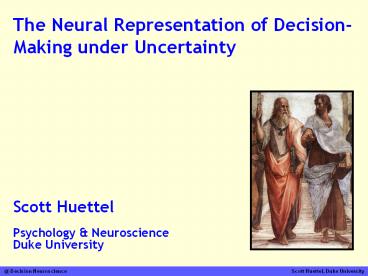@ Decision Neuroscience Scott Huettel, Duke University - PowerPoint PPT Presentation
Title:
@ Decision Neuroscience Scott Huettel, Duke University
Description:
between the measurable uncertainty and an unmeasurable one we may use the term ... 'Information occurs only if there exists some a priori uncertainty, and the ... – PowerPoint PPT presentation
Number of Views:213
Avg rating:3.0/5.0
Title: @ Decision Neuroscience Scott Huettel, Duke University
1
The Neural Representation of Decision-Making
under Uncertainty
- Scott Huettel
- Psychology Neuroscience
- Duke University
2
there are known knowns there are things we
know we know. We also know there are known
unknowns that is to say we know there are some
things we do not know. But there are also
unknown unknowns -- the ones we don't know we
don't know. - Rumsfeld (2003, in
press)
3
To preserve the distinction between the
measurable uncertainty and an unmeasurable one we
may use the term risk to designate the former
and the term uncertainty for the latter. It
is this type of uncertainty which has been
neglected in economic theory, and which we
propose to put in its rightful place.
F. H. Knight (1921) Risk,
Uncertainty, Profit
4
Outline of the Talk
- Uncertainty defined
- Case study Ambiguity
- Contributions of lateral prefrontal, parietal
cortex? - Contributions of orbitofrontal cortex, amygdala?
- Discussion What should neuroscience seek?
5
Wendell Tex Garner
6
(No Transcript)
7
Lateral PFC
Sequence Length
LPFC
BOLD Signal Change
LPFC
Huettel, Mack, McCarthy (2002) Nature
Neuroscience
8
Ubiquitous Risk Signals
Posterior Cingulate
9
From Glimcher Rustichini (2004) Science.
10
Risk vs. Ambiguity
Trial Types
Risky - Certain
Ambiguous - Certain
Risky - Risky
Ambiguous - Risky
Trial Structure
Decision (RT)
Expectation (4.5-6s)
Outcome (2s)
Huettel et al. (2006) Neuron
11
L
12
Risk Expected Utility
Ambiguity a MaxMin Expected Utility
Subjects (n13)
13
Ambiguity in Lateral Prefrontal Cortex?
Ambiguity Preference
Risk Preference
More (3)
(0) Less
(AC AR) (RC RR)
(RC RR) - (AC AR)
a - Ambiguity
ß - Risk
LPFC
More (1)
(0) Less
Correlation with Economic Preference
aINS
LPFC
Resampling Analysis
pPAR
Ambiguity preference (1-a)
Risk preference (ß)
14
Ambiguity in Orbitofrontal Cortex?
Hsu et al. (2005) Science
15
Evidence from Cognitive Neuroscience
- Lateral prefrontal cortex
- Important for establishing rules for behavior
- Implicated in reasoning, response selection
- Orbitofrontal cortex
- Important for learning about (aversive) stimuli
- Implicated in inhibition of behavior
16
Interim Take-Home MessageConcepts from decision
science are unlikely to reflect unitary
psychological constructs nor single neural
modules
17
Conditioning of Risk and Ambiguity
Here, ambiguity reflects the expected revelation
of information
i.e., a potentially known unknown.
Bach et al. (2009) J Neurosci
18
Stimuli involving ambiguity evoked greater
activation in dlPFC and PPC than those involving
risk or ignorance.
Bach et al. (2009) J Neurosci
19
In a task similar to an implicit Wisconsin Card
Sorting Task (i.e., learning rules without
immediate feedback) stimuli that eliminate
potential rules evokes activation in lateral PFC
(the posterior
inferior frontal sulcus) proportional to the
eliminated rules.
pIFS
Huettel Misiurek (2004)
20
Ventral PFC Damage Increases Risk Seeking
Clark et al. (2008) Brain
Cf. Goel et al. (2007) Cerebral Cortex, who argue
for potential laterality effects in reasoning
RH impairs under incomplete information
21
Kringelbach (2005) Nat. Rev. Neurosci
22
- Ambiguity effects in orbital PFC
- Tasks (3) Gambles, knowledge, opponent
- Activation preceded decision (slow)
- Aversion led to increased activation
- Subject sample very ambiguity averse
- Ambiguity effects in lateral PFC
- Task (1) Gambles
- Activation coincident with decision (fast)
- Aversion led to decreased activation
- Subject sample ambiguity neutral
Emotional aversion signal pushes behavior away
from ambiguous/risky options?
Hsu et al. (2005) Science
LPFC
Cognitive signal supports creation of decision
scenario under ambiguity?
Huettel et al. (2006) Neuron
23
A Lesson from Psychology for Neuroeconomics?
- A concept that is synonymous with a single
operation is nothing more than a restatement of
an experimental result. But a concept that arises
as a consequence of converging operations has a
reality that is independent of any single
experimental observation. - But before we can get convergence, we must
introduce variation in our experimental
procedures. Stabilizing on a few techniques
is utterly self-defeating because it
completely drops the critical part from critical
realism. - The Processing of Information and Structure p. 187
Wendell Tex Garner
24
Acknowledgments
- Collaborators on these Projects
- Gregory McCarthy
- Michael Platt
- Laboratory Members
- McKell Carter
- Chris Coutlee
- John Clithero
- Debra Henninger
- O. Mullette-Gillman
- Brandi Newell
- Allison Scott
- David Smith
- Adrienne Taren
- Vinod Venkatraman
- Richard Yaxley
- Support
- NIMH, NINDS, NIA
- Duke Institute for Brain Sciences































